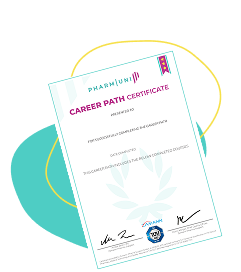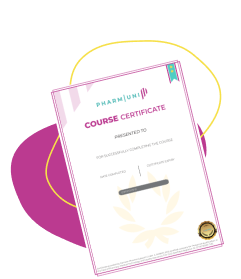Unlock the potential of your career in the Pharma industry with our online courses and qualifications.

Pick a career path, follow its guided course roadmap, and secure industry-verified credentials in a few months.

Earn career credentials from industry leaders that demonstrate your expertise.
Are you ready to take charge of your professional development in the pharmaceutical industry? Our Pharma Skill Tree is designed to help you visualize and track your skills and competencies, guiding you through essential areas such as Quality Assurance (QA), Quality Control (QC), and Regulatory Affairs.

Gain insights into your current skills and knowledge levels through our detailed assessments. The skill tree visually maps your competencies, highlighting strengths and areas for improvement.
Receive tailored recommendations based on your assessment results and career aspirations. Our platform guides you to relevant courses and training resources designed to bridge skill gaps and enhance your qualifications.
Define your career objectives with clear, achievable goals. Our user-friendly interface allows you to track your progress as you complete courses and master new skills, providing motivation and accountability.
Define your career objectives with clear, achievable goals. Our user-friendly interface allows you to track your progress as you complete courses and master new skills, providing motivation and accountability.
Access a wide range of courses that are specifically designed for the pharmaceutical industry. From advanced regulatory compliance training to essential QA and QC practices, our offerings are tailored to meet the demands of the rapidly evolving pharmaceutical landscape.




Unlock new career opportunities in industry with our innovative skill tree feature.
We use cookies to improve your experience on our site. By using our site, you consent to cookies. Privacy Policy
Manage your cookie preferences below:
Essential cookies enable basic functions and are necessary for the proper function of the website.
These cookies are needed for adding comments on this website.
Google Tag Manager simplifies the management of marketing tags on your website without code changes.
These cookies are used for managing login functionality on this website.
Statistics cookies collect information anonymously. This information helps us understand how visitors use our website.
Google Analytics is a powerful tool that tracks and analyzes website traffic for informed marketing decisions.
Service URL: policies.google.com
Clarity is a web analytics service that tracks and reports website traffic.
Service URL: clarity.microsoft.com
Marketing cookies are used to follow visitors to websites. The intention is to show ads that are relevant and engaging to the individual user.
Facebook Pixel is a web analytics service that tracks and reports website traffic.
Service URL: www.facebook.com
LinkedIn Insight is a web analytics service that tracks and reports website traffic.
Service URL: www.linkedin.com
You can find more information in our Privacy Policy and Privacy Policy.